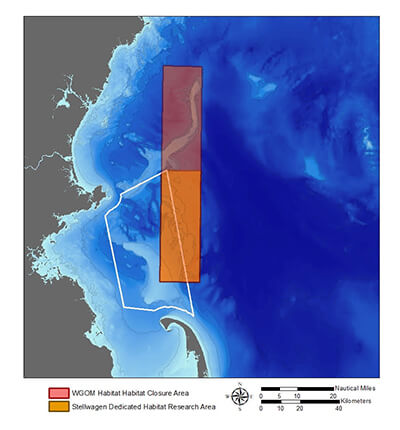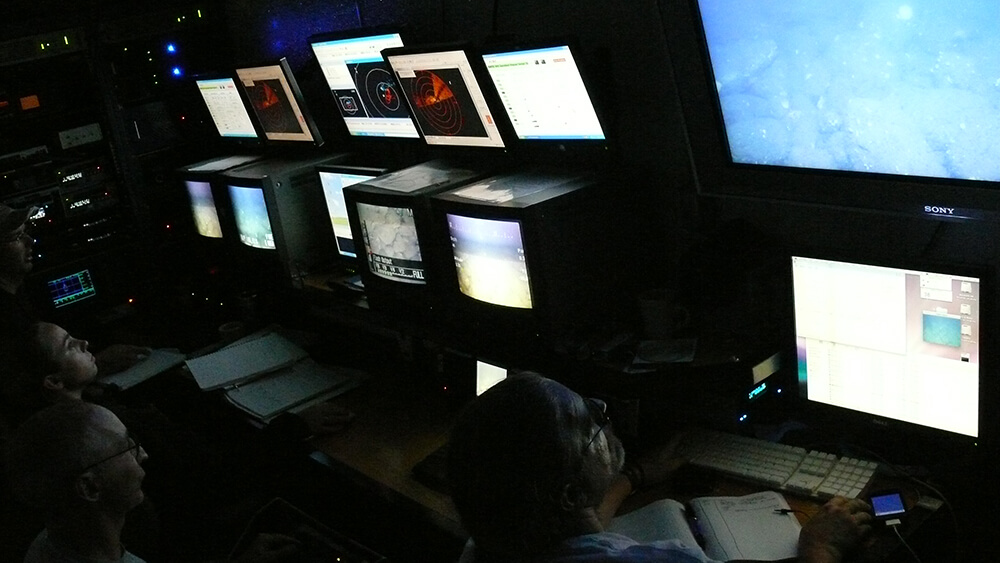Biodiversity and Habitats
Sanctuary staff have determined that well over 575 species reside in and around Stellwagen Bank. Many of the single-celled and smaller life forms are only now being recognized. Sanctuary staff are interested in the diversity of species and habitats in the sanctuary, how they are affected by negative impacts, and how they recover.
SDHRA -- Stellwagen Dedicated Habitat Research Area

When the New England Fisheries Management Council and NOAA Fisheries created the Western Gulf of Maine Closure Area in 1998 (area closed to groundfishing) and then overlaid it with a Stellwagen Dedicated Habitat Research Area in 2015, they overlapped 22% of the sanctuary. Fortuitously, this area with restricted fishing along the eastern edge of the sanctuary, labeled "the sliver," provides researchers with undisturbed seafloor sites to contrast with fished areas of similar habitat type nearby. Studies include the recently concluded Seafloor Habitat Recovery Monitoring Program (SHRMP) program (see next section). The Stellwagen Designated Habitat Research Area is rated at a "Level 3 Habitat Closed Area," which means it is closed year-round to all bottom-tending gear, as well as bottom-tending gillnets, clam and scallop dredges, and shrimp trawls. Visit NOAA Fisheries for more information on the Western Gulf of Maine Groundfish Closure and Habitat Areas.
See an example of sanctuary studies of fishing pressures inside and outside the SDHRA on page 52 of the 2020 Condition Report.
SHRMP – Seafloor Habitat Recovery Monitoring Program

Studies inside and outside the Western Gulf of Maine Closure Area, located within the sanctuary, show a marked difference in community development. Marine life in the no-fishing areas is recovering, but slowly, while areas that continue to be fished show little three-dimensional growth and fewer animals. Questions remain as to whether an area can completely recover after significant disturbance or if natural forces will lead to a new community and species assemblage. Read the report. A summary can be found on page 104 of the 2020 Condition Report.
Larval Settlement and Community Development on Shipwrecks
A two-year project with shipwrecks in the sanctuary includes a study of invertebrate communities and larval recruitment. Scientists from Woods Hole Oceanographic Institution will identify and quantify the various species on the wrecks, which often serve as oases of three-dimensional structure on the flat seafloor, and compare these findings with communities on natural boulder reefs nearby. See our expedition pages.
HabCam Images of Sanctuary Seafloor
Woods Hole Oceanographic Institution's HabCam (Habitat Mapping Camera System) group images the sanctuary seafloor at six frames a second. The sanctuary was one of the sites covered in a northeastern bentho-pelagic observatory project. The image collection, which details many of the seafloor habitats and species, has been used by the sanctuary to assess locations and concentrations of derelict fishing gear.
Mapping Microbial Diversity
Microbial communities in seafloor sediments play an important foundational role in the entire food web in marine ecosystems – they decompose organic matter, recycle nutrients, and remove biotoxins. They account for a large portion of the biomass in the ocean. A research team is investigating microbial biodiversity in the sanctuary to assess the health of the food web, inform conservation practices, and identify novel gene clusters that may have the potential to improve public health. Partners include the University of New Hampshire and the Marine Microverse Institute.
Learn more about the sanctuary's sediment microbial community in this Marine Genomics paper.

